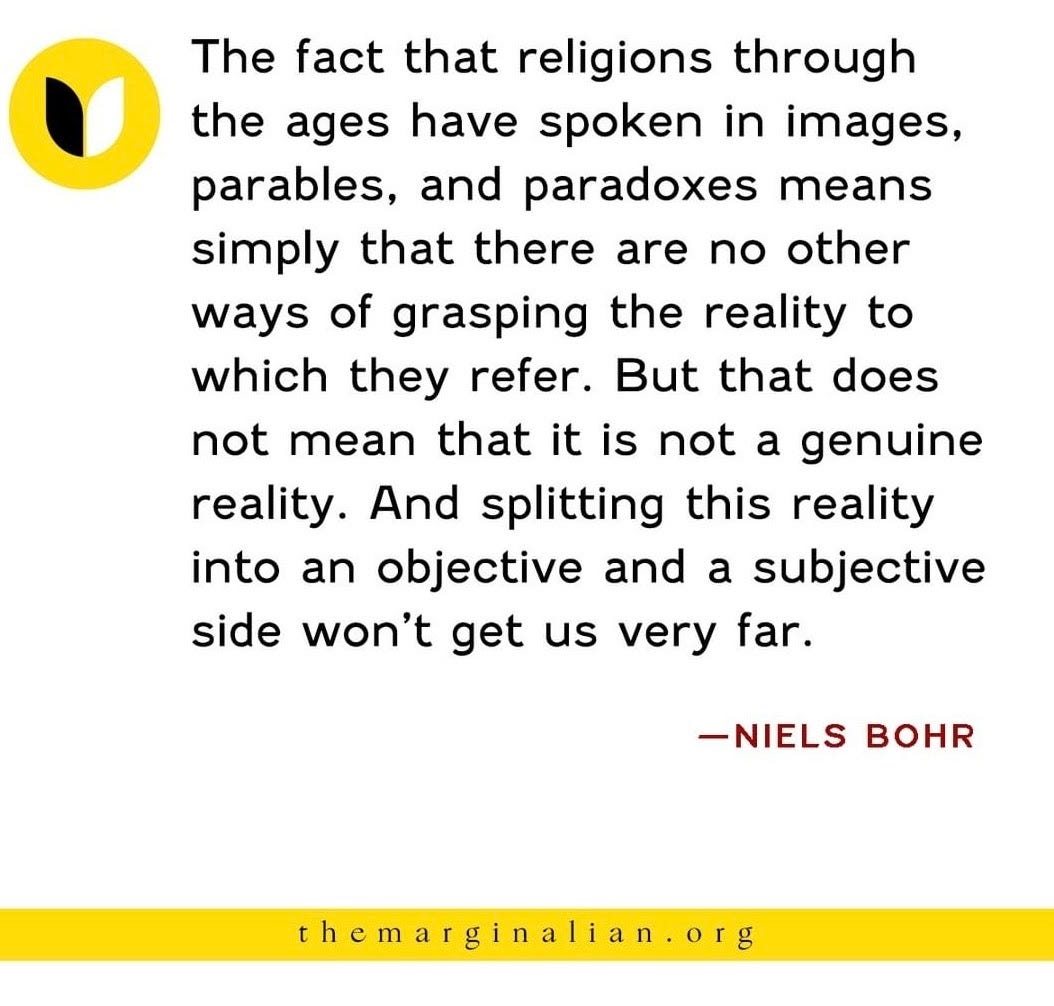"Everyday Interactions With The Unseen"
In which we explore Djinn, Horseshoes and a universal symbol of hope
Small gestures like knocking on wood, crossing fingers or carrying ‘lucky charms’ are often bundled into the category of ‘superstition’ and dismissed as hangovers of some naive age that only serve to ‘bring peace of mind’. Which strikes my childlike curious mind as a little dismissive and condescending. What tickles my nerd-brain about these gestures is the more important part they play in society in general, which is what we’re going to look into today.
Interacting With The Otherworld
That’s a fun subtitle, isn’t it? It gives you the sense that you’re waving some hawthorn wand at the fog like some mad, bearded wizard. Which, frankly, is a life goal.
In reality, dozens of little ‘rituals’ are ever present in our daily lives and we barely give them a second thought. The most common of these are gestures that play with the ‘other/unseen’ world by invoking ‘good luck’ or attempt to ward off luck of the other kind. You probably even perform some of them yourself, without ever believing that you’re putting yourself in contact with anything more spiritual than hoping your ticket numbers appear on the telly.
As I said, these are just gestures but, if given a little thought, can reveal interesting things about supposedly mundane actions.
Knock on wood / Touch wood
I discussed belief in Fairies in a previous Pop Mythology, in which I talked about how acknowledging their presence (even without any real ‘spiritual’ conviction) can help people reconcile the age-old conundrum, ‘why is there malice in the world?’
[Spoiler: it’s because Fairies can be little shits who symbolise forces outside of our control.]
However, belief in Fairies has had lasting effects on society in the ritual of knocking on wood.
This gesture is very common in the UK and US, where a soft rap of the knuckles on anything made of wood is an invocation of good luck or used to dispel some bad thought of misfortune. If you do this yourself (as I have done compulsively for as long as I can remember) then you’re actually performing an ancient ritual designed to invoke the favour of the spirits that live inside the wood itself.
This comes from the animistic roots of human history and this awareness of ‘unseen beings’ can be enormously helpful from a perspective of mindfulness.
Fingers Crossed
The ‘national lottery’ is where the Venn diagram of ‘real and unreal’ converges on a regular basis. After all, there is nowhere else that millions of people spend their hard-earned money to participate in such a vast ritual of hope/luck-bringing.
The act of crossing our fingers is one of the most visible symbols in all Western society and that's why it was chosen as the logo of a number of lotteries around the world, as you can see from the image above of the UK national lottery logo.
There are many theories about the origin of this symbol, some even going back to pre-Christian times. These theories all seem to suggest two things:
Initially, two people would cross their index fingers with each other to ward off malicious forces.
Also, the earliest use of this symbol appears to have been an invocation of sacred geometry, which was the belief that certain shapes could be of powerful spiritual importance.
It’s unclear exactly when people started making the ‘cross’ with their own fingers in the way it is popular today but it has become one of the most visible signs of wishing for luck in modern times.
What’s really beautiful about this gesture is that, although it has ‘mystical’ roots to some degree, there’s no real religion or spiritualism needed for it to benefit anybody. Wishing for luck is a universal sentiment and crossing your fingers unifies you through meaning with anybody else who grew up in a culture that recognises the symbol.
If we choose to add a little woo woo to our lives, however, this symbol becomes a powerful storytelling device for the narratives of our own minds, which can have positive real-world effects.
The Protection of Djinn
In Islamic belief there is an important tradition of an “unseen” realm known as Al-Ghaib.
Al-Ghaib refers to all elements of the divine, including the future, which only God is believed to know. Al-Ghaib is also a ‘place’ that is inhabited by divine beings like God, Angels and Djinn.
Very often we think of ‘Djinn’ as either genies trapped in a bottle or as synonymous with ‘Demons’ from Christian tradition. However, in Islam, just as in early Christianity, the reality is much more interesting.
The term ‘Demon’ originally comes from the ancient Greek word Daimon, which referred to any spirit or spiritual power. This was often any kind of ‘divine personality’ that was external to a person’s own. So common was the idea, in fact, that when Socrates was asked if he believed he had committed malicious acts he replied that his Daimon had always guided him well in his actions. By giving the name Daimon to what was essentially his conscience, Socrates was giving his conscience agency in the real world and implying that his personal Daimon was a benevolent force.
In Islam, there are good, bad and neutral Djinn. Just like humans. They have different powers to humans but their intentions are not always malevolent. That being said, if you can avoid their displeasure then you’ll be less likely to incur ‘bad luck’.
One such way of avoiding making a good, neutral or bad Djinn grumpy is to warn them to get out of the plumbing (Djinn enjoy chilling out where there is still water, apparently) before you pour hot water down the drain.
To do this, Muslims say "Bismillah" بسم الل (translation: "In the name of Allah") or any other small prayer or surah from Quran (think of surah as a chapter and ayah as a verse in the surah), for example: verse 2:255 from the Quran which is called Ayatul Kursi ("the Verse of the Throne") or the short prayer: "A'udhu billahi minash shaitanir rajim." أعوذ بالله من الشيطان الرجيم (translation: “I seek shelter in Allah from the rejected shaytan (evil jinn)."
Note that it is forbidden to hurt Djinn in Islam, even ones you might call ‘baddies’. No ‘bad’ or ‘neutral’ Djinn is beyond mercy and none of them deserve a scolding when they’re just trying to get on with their lives, as we are. This is an example of maintaining unequivocal compassion for the ‘other’ regardless of their actions, inherent quality or even demonstrative reality.
And there is an important lesson we can take from this. Acting out rituals in the ‘spiritual realm’ - if done without cynicism - can allow us to practice compassion towards our fellow creatures in the ‘tangible’ realm.
The Unifying Horseshoe Theory
Whenever there’s talk of bringing together ‘religious’ thinking with real-world application someone inevitably brings up Niels Bohr. Today, that someone is me.
Niels Bohr was a Danish Nobel-prize-winning physicist about whom there are dozens hilarious anecdotes. One of these - possibly apocryphal but se non è vero, è molto ben trovato - describes a guest finding a curious good-luck charm in Bohr’s house.
According to the story, the guest saw a horseshoe hanging either from the entrance or above Bohr’s desk and the man asked the renowned physicist if he believed in such superstitions. To which Bohr replied, “No, but I am told that they bring luck even to those who do not believe in them.”
Regardless of the veracity of this anecdote, people attribute it to Bohr because it rings true of his views on the world in general. Take, for instance, the following quote from the inimitable Marginalian:
The paradox of a physicist allowing himself to merge objective and subjective realities is at the heart of this week’s Pop Mythology. Splitting the secular and non-secular has many worldly benefits that we, as a culture, are still wrestling with. But so too does notsplitting them at times.
Wishing for good luck or hoping bad luck doesn’t come your way is an act of unifying objective and subjective realities and we have normalised it beautifully without the need for dogma or tribalism.
Just take a moment and think about how many things you do in your day that invoke the ‘unseen’. These could be any of the ‘rituals’ on this list or perhaps even a ‘lucky object’ you carry around with yourself, or even something that reminds you of somebody who is no longer in your life. You might not say that you’re not invoking anything supernatural but you’re certainly invoking a memory or a feeling that anybody would understand, no matter how ‘unbelieving’ they are.
This is the paradox Bohr was referring to. Cognitive dissonance is a wonderful tool for good, as much as it can be used for propagating ignorance. We may know that objective reality is the only reality but we do well when we tell stories that paint reality with beneficial subjectivity.
At least that’s how it seems to me, anyway.
How about you? Let us know what you think and if you have any other ‘interactions with the unseen’ that you find yourself making in your daily lives.






